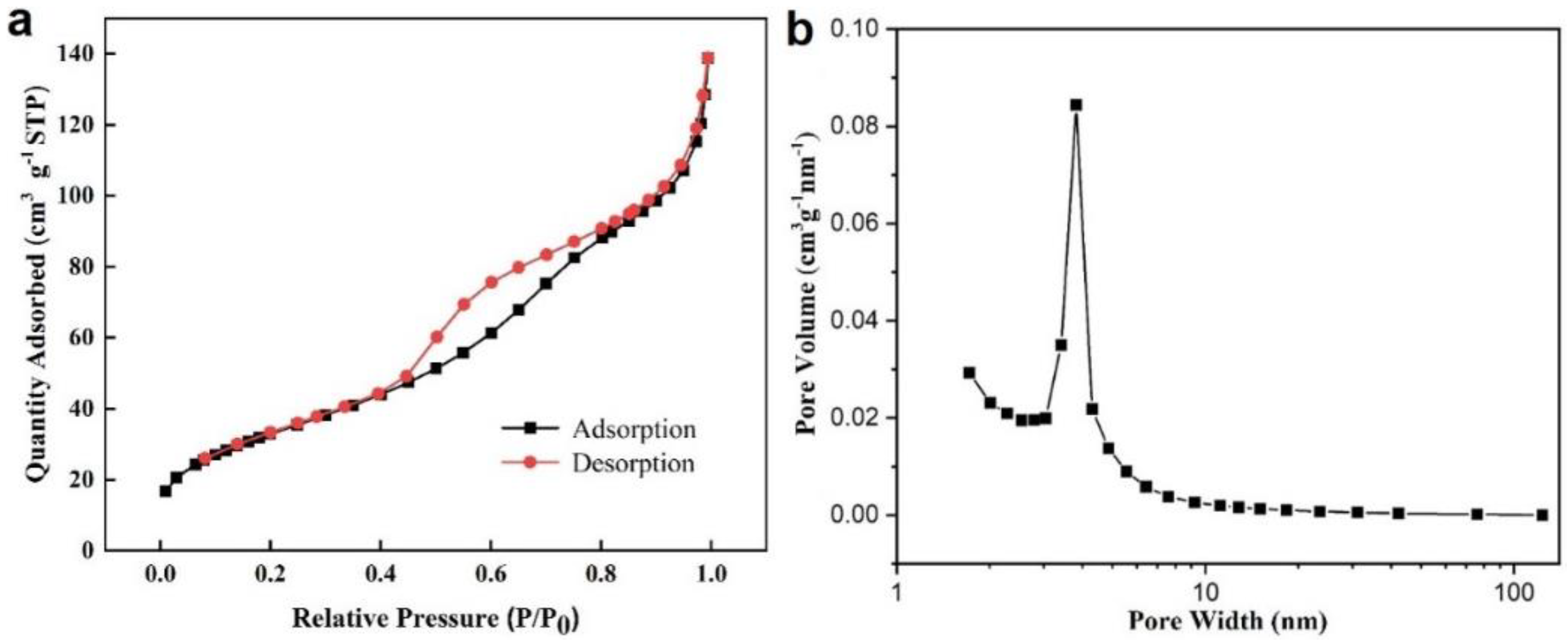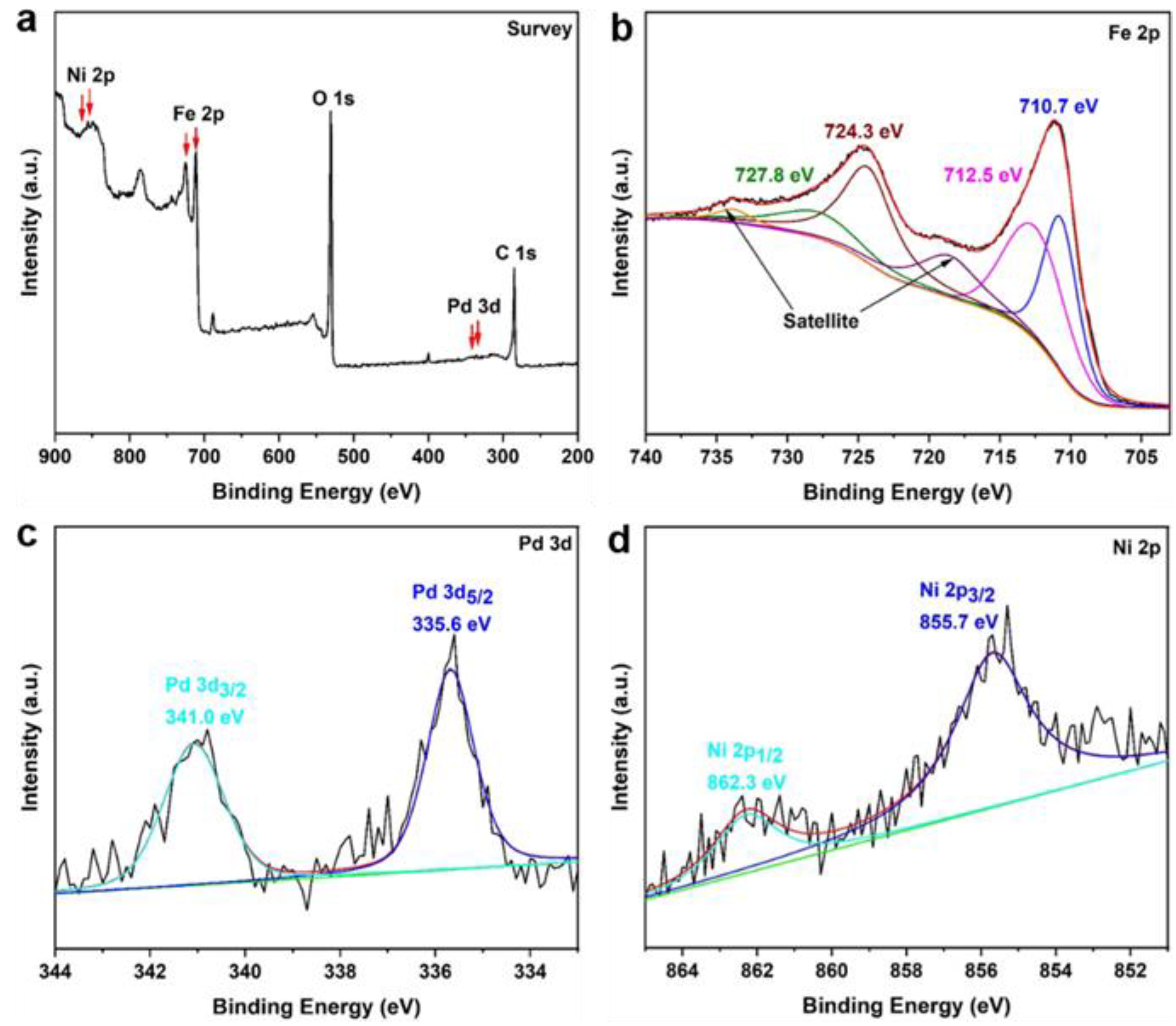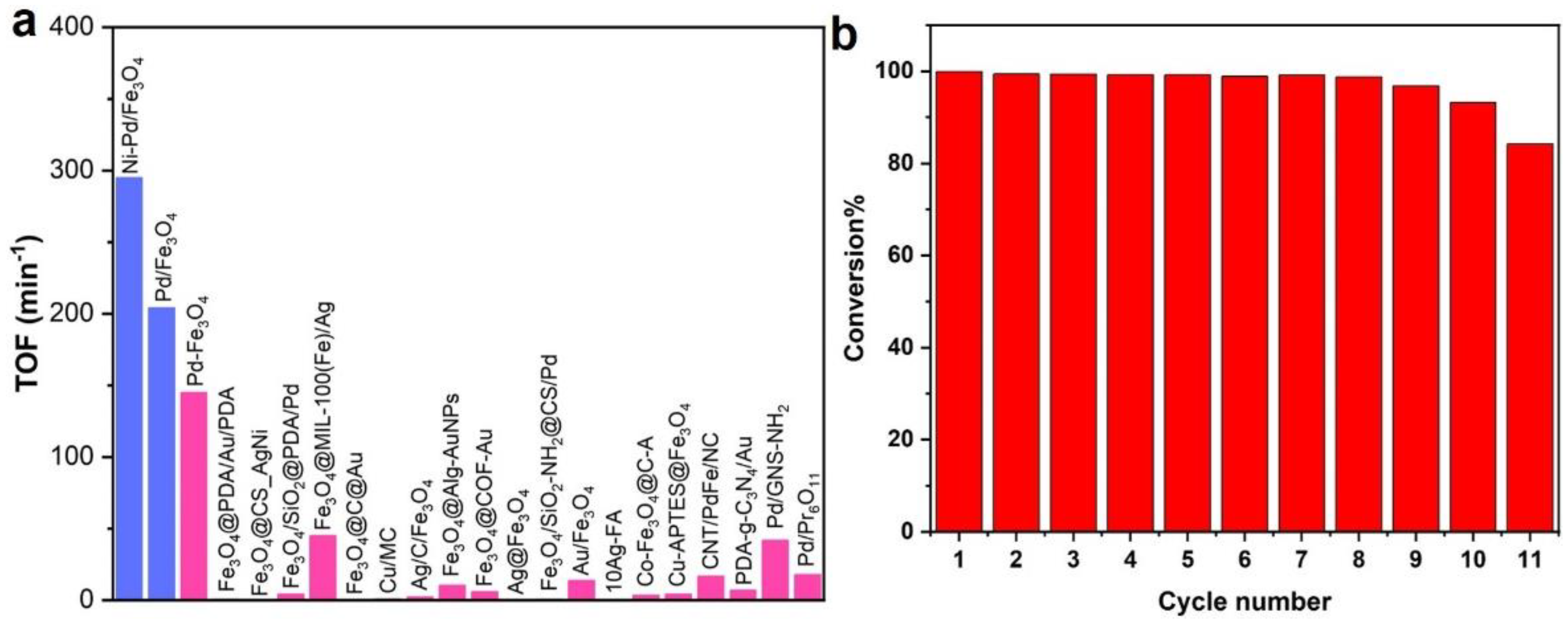Ni-Pd-Incorporated Fe3O4 Yolk-Shelled Nanospheres as Efficient Magnetically Recyclable Catalysts for Reduction of N-Containing Unsaturated Compounds
Abstract
:1. Introduction
2. Results and Discussions
2.1. Preparation and Characterization of the Ni-Pd/Fe3O4 Catalyst
2.2. Catalytic Performance of the Ni-Pd/Fe3O4 Catalyst
3. Materials and Methods
3.1. Materials Preparation
3.2. Catalytic Measurements of Ni-Pd/Fe3O4 Catalyst
3.2.1. Reduction of 4-NP, CR, and MO
3.2.2. Recyclability or Durability Test
4. Conclusions
Supplementary Materials
Author Contributions
Funding
Data Availability Statement
Conflicts of Interest
References
- Parida, D.; Moreau, E.; Nazir, R.; Salmeia, K.A.; Frison, R.; Zhao, R.; Lehner, S.; Jovic, M.; Gaan, S. Smart hydrogel-microsphere embedded silver nanoparticle catalyst with high activity and selectivity for the reduction of 4-nitrophenol and azo dyes. J. Hazard. Mater. 2021, 416, 126237. [Google Scholar] [CrossRef]
- Wang, H.; Zhang, G.; Mia, R.; Wang, W.; Xie, L.; Lü, S.; Mahmud, S.; Liu, H. Bioreduction (Ag+ to Ag0) and stabilization of silver nanocatalyst using hyaluronate biopolymer for azo-contaminated wastewater treatment. J. Alloys. Compd. 2022, 894, 162502. [Google Scholar] [CrossRef]
- Guo, S.; Yang, Z.; Zhang, H.; Yang, W.; Li, J.; Zhou, K. Enhanced photocatalytic degradation of organic contaminants over CaFe2O4 under visible LED light irradiation mediated by peroxymonosulfate. J. Mater. Sci. Technol. 2021, 62, 34–43. [Google Scholar] [CrossRef]
- Guo, S.; Zhang, L.; Chen, M.; Ahmad, F.; Fida, H.; Zhang, H. Heterogeneous activation of peroxymonosulfate by a spinel CoAl2O4 catalyst for the degradation of organic pollutants. Catalysts 2022, 12, 847. [Google Scholar] [CrossRef]
- Singh, P.; Roy, S.; Jaiswal, A. Cubic gold nanorattles with a solid octahedral core and porous shell as efficient catalyst: Immobilization and kinetic analysis. J. Phys. Chem. C 2017, 121, 22914–22925. [Google Scholar] [CrossRef]
- He, Z.; Liu, J.; Wang, Q.; Zhao, M.; Wen, Z.; Chen, J.; Manoj, D.; Xie, C.; Xi, J.; Yu, J. Metal-free carbocatalyst for catalytic hydrogenation of N-containing unsaturated compounds. J. Catal. 2019, 377, 199–208. [Google Scholar] [CrossRef]
- Wei, H.; Liu, X.; Wang, A.; Zhang, L.; Qiao, B.; Yang, X.; Huang, Y.; Miao, S.; Liu, J.; Zhang, T. FeOx-supported platinum single-atom and pseudo-single-atom catalysts for chemoselective hydrogenation of functionalized nitroarenes. Nat. Commun. 2014, 5, 5634. [Google Scholar] [CrossRef] [Green Version]
- Hu, H.; Du, S.; Xi, J. N-doped holey graphene assembled on fibrous aluminium silicate for efficient carbocatalysis in fixed-bed system. Green Chem. 2022, 24, 5255–5262. [Google Scholar] [CrossRef]
- Xi, J.; Wang, Q.; Liu, J.; Huan, L.; He, Z.; Qiu, Y.; Zhang, J.; Tang, C.; Xiao, J.; Wang, S. N,P-dual-doped multilayer graphene as an efficient carbocatalyst for nitroarene reduction: A mechanistic study of metal-free catalysis. J. Catal. 2018, 35, 233–241. [Google Scholar] [CrossRef]
- Islam, M.T.; Saenz-Arana, R.; Wang, H.; Bernal, R.; Noveron, J.C. Green synthesis of gold, silver, platinum, and palladium nanoparticles reduced and stabilized by sodium rhodizonate and their catalytic reduction of 4-nitrophenol and methyl orange. New J. Chem. 2018, 42, 6472–6478. [Google Scholar] [CrossRef]
- Qin, L.; Yi, H.; Zeng, G.; Lai, C.; Huang, D.; Xu, P.; Fu, Y.; He, J.; Li, B.; Zhang, C.; et al. Hierarchical porous carbon material restricted Au catalyst for highly catalytic reduction of nitroaromatics. J. Hazard. Mater. 2019, 380, 120864. [Google Scholar] [CrossRef]
- Xu, H.; Xiao, Y.; Xu, M.; Cui, H.; Tan, L.; Feng, N.; Liu, X.; Qiu, G.; Dong, H.; Xie, J. Microbial synthesis of Pd-Pt alloy nanoparticles using Shewanella oneidensis MR-1 with enhanced catalytic activity for nitrophenol and azo dyes reduction. Nanotechnology 2019, 30, 065607. [Google Scholar] [CrossRef] [PubMed]
- Zhang, N.; Qiu, Y.; Sun, H.; Hao, J.; Chen, J.; Xi, J.; Liu, J.; He, B.; Bai, Z.-W. Substrate-assisted encapsulation of Pd-Fe bimetal nanoparticles on functionalized silica nanotubes for catalytic hydrogenation of nitroarenes and azo dyes. ACS. Appl. Nano Mater. 2021, 4, 5854–5863. [Google Scholar] [CrossRef]
- Xi, J.; Huang, J.; Wang, D.; Wen, L.; Hao, J.; He, B.; Chen, J.; Bai, Z.W. Probing activity enhancement of photothermal catalyst under near-infrared irradiation. J. Phys. Chem. Lett. 2021, 12, 3443–3448. [Google Scholar] [CrossRef]
- Xi, J.; Wang, Q.; Duan, X.; Zhang, N.; Yu, J.; Sun, H.; Wang, S. Continuous flow reduction of organic dyes over Pd-Fe alloy based fibrous catalyst in a fixed-bed system. Chem. Eng. Sci. 2021, 231, 116303. [Google Scholar] [CrossRef]
- Yang, J.; Wang, W.D.; Dong, Z. PdCo nanoparticles supported on carbon fibers derived from cotton: Maximum utilization of Pd atoms for efficient reduction of nitroarenes. J. Colloid. Interf. Sci. 2018, 524, 84–92. [Google Scholar] [CrossRef] [PubMed]
- Zhuang, Z.; Yang, Q.; Chen, W. One-step rapid and facile synthesis of subnanometer-sized Pd6(C12H25S)11 clusters with ultra-high catalytic activity for 4-nitrophenol reduction. ACS. Sustain. Chem. Eng. 2019, 7, 2916–2923. [Google Scholar] [CrossRef]
- Yang, X.; Wang, J.; Wei, Y.; Li, B.; Yan, W.; Yin, L.; Wu, D.; Liu, P.; Zhang, P. Cotton-derived carbon fiber-supported Ni nanoparticles as nanoislands to anchor single-atom Pt for efficient catalytic reduction of 4-nitrophenol. Appl. Catal. A-Gen. 2022, 643, 118734. [Google Scholar] [CrossRef]
- Xi, J.; Sun, H.; Wang, D.; Zhang, Z.; Duan, X.; Xiao, J.; Xiao, F.; Liu, L.; Wang, S. Confined-interface-directed synthesis of Palladium single-atom catalysts on graphene/amorphous carbon. Appl. Catal. B-Environ. 2018, 225, 291–297. [Google Scholar] [CrossRef] [Green Version]
- Veisi, H.; Moradi, S.B.; Saljooqi, A.; Safarimehr, P. Silver nanoparticle-decorated on tannic acid-modified magnetite nanoparticles (Fe3O4@TA/Ag) for highly active catalytic reduction of 4-nitrophenol, Rhodamine B and Methylene blue. Mater. Sci. Eng. C Mater. Biol. Appl. 2019, 100, 445–452. [Google Scholar] [CrossRef]
- Zhao, L.; Qin, X.; Zhang, X.; Cai, X.; Huang, F.; Jia, Z.; Diao, J.; Xiao, D.; Jiang, Z.; Lu, R.; et al. A magnetically separable Pd single-atom catalyst for efficient selective hydrogenation of phenylacetylene. Adv. Mater. 2022, 34, e2110455. [Google Scholar] [CrossRef]
- Koli, P.B.; Kapadnis, K.H.; Deshpande, U.G. Transition metal decorated ferrosoferric oxide (Fe3O4): An expeditious catalyst for photodegradation of carbol fuchsin in environmental remediation. J. Environ. Chem. Eng. 2019, 7, 103373. [Google Scholar] [CrossRef]
- Singh, P.; Mishra, S.; Sahoo, A.; Patra, S. A magnetically retrievable mixed-valent Fe3O4@SiO2/Pd0/PdII nanocomposite exhibiting facile tandem Suzuki coupling/transfer hydrogenation reaction. Sci. Rep. 2021, 11, 9305. [Google Scholar] [CrossRef] [PubMed]
- Kurtan, U.; Amir, M.; Yıldız, A.; Baykal, A. Synthesis of magnetically recyclable MnFe2O4@SiO2@Ag nanocatalyst: Its high catalytic performances for azo dyes and nitro compounds reduction. Appl. Surf. Sci. 2016, 376, 16–25. [Google Scholar] [CrossRef]
- Kurtan, U.; Amir, M.; Baykal, A. Fe3O4@ Nico-Ag magnetically recyclable nanocatalyst for azo dyes reduction. Appl. Surf. Sci. 2016, 363, 66–73. [Google Scholar] [CrossRef]
- Gawande, M.B.; Branco, P.S.; Varma, R.S. Nano-magnetite (Fe3O4) as a support for recyclable catalysts in the development of sustainable methodologies. Chem. Soc. Rev. 2013, 42, 3371–3393. [Google Scholar] [CrossRef] [PubMed]
- Wang, X.; Feng, J.; Bai, Y.; Zhang, Q.; Yin, Y. Synthesis, Properties, and Applications of hollow micro-/nanostructures. Chem. Rev. 2016, 116, 10983–11060. [Google Scholar] [CrossRef]
- Zhu, M.; Cheng, Y.; Luo, Q.; El-khateeb, M.; Zhang, Q. A review of synthetic approaches to hollow nanostructures. Mater. Chem. Front. 2021, 5, 2552–2587. [Google Scholar] [CrossRef]
- Prieto, G.; Tuysuz, H.; Duyckaerts, N.; Knossalla, J.; Wang, G.H.; Schuth, F. Hollow nano- and microstructures as catalysts. Chem. Rev. 2016, 116, 14056–14119. [Google Scholar] [CrossRef]
- Li, J.; Ren, J.; Yang, G.; Wang, P.; Li, H.; Sun, X.; Chen, L.; Ma, J.-T.; Li, R. Simple and efficient deposition of Pd nanoparticles on Fe3O4 hollow nanospheres: A new catalytic system for methanol oxidation in alkaline media. Mater. Sci. Eng. B 2010, 172, 207–212. [Google Scholar] [CrossRef]
- Li, Y.; Zhang, Y.; Qian, K.; Huang, W. Metal–support interactions in metal/oxide catalysts and oxide–metal interactions in oxide/metal inverse catalysts. ACS. Catal. 2022, 12, 1268–1287. [Google Scholar] [CrossRef]
- Neumann, S.; Doebler, H.H.; Keil, S.; Erdt, A.J.; Gutsche, C.; Borchert, H.; Kolny-Olesiak, J.; Parisi, J.; Baäumer, M.; Kunz, S. Effects of particle size on strong metal–support interactions using colloidal “Surfactant-Free” Pt nanoparticles supported on Fe3O4. ACS Catal. 2020, 10, 4136–4150. [Google Scholar] [CrossRef]
- Yang, S.; Cao, C.; Sun, Y.; Huang, P.; Wei, F.; Song, W. Nanoscale magnetic stirring bars for heterogeneous catalysis in microscopic systems. Angew. Chem. Int. Ed. 2015, 54, 2661–2664. [Google Scholar] [CrossRef] [PubMed]
- Duan, X.; Liu, J.; Hao, J.; Wu, L.; He, B.; Qiu, Y.; Zhang, J.; He, Z.; Xi, J.; Wang, S. Magnetically recyclable nanocatalyst with synergetic catalytic effect and its application for 4-nitrophenol reduction and suzuki coupling reactions. Carbon 2018, 130, 806–813. [Google Scholar] [CrossRef]
- Wen, L.; Wang, D.; Xi, J.; Tian, F.; Liu, P.; Bai, Z.-W. Heterometal modified Fe3O4 hollow nanospheres as efficient catalysts for organic transformations. J. Catal. 2022, 413, 779–785. [Google Scholar] [CrossRef]
- Li, C.; Luan, Y.; Zhao, B.; Kumbhar, A.; Chen, X.; Collins, D.; Zhou, G.; Fang, J. Facet-dependent catalysis of CuNi nanocatalysts toward 4-nitrophenol reduction reaction. MRS. Adv. 2020, 5, 1491–1496. [Google Scholar] [CrossRef]
- Li, C.; Luan, Y.; Zhao, B.; Kumbhar, A.; Fang, J. Size-controlled synthesis of CuNi nano-octahedra and their catalytic performance towards 4-nitrophenol reduction reaction. MRS. Adv. 2019, 4, 263–269. [Google Scholar] [CrossRef]
- Pino, N.; Sitthisa, S.; Tan, Q.; Souza, T.; López, D.; Resasco, D.E. Structure, activity, and selectivity of bimetallic Pd-Fe/SiO2 and Pd-Fe/γ-Al2O3 catalysts for the conversion of furfural. J. Catal. 2017, 350, 30–40. [Google Scholar] [CrossRef] [Green Version]
- Handa, S.; Wang, Y.; Gallou, F.; Lipshutz, B.H. Sustainable Fe–ppm Pd nanoparticle catalysis of Suzuki-Miyaura cross-couplings in water. Science 2015, 349, 1087–1091. [Google Scholar] [CrossRef] [Green Version]
- Ma, F.; Hu, H.; Wu, H.; Xu, C.; Xu, Z.; Zhen, L.; Lou, X. Formation of uniform Fe3O4 hollow spheres organized by ultrathin nanosheets and their excellent lithium storage properties. Adv. Mater. 2015, 27, 4097–4101. [Google Scholar] [CrossRef]
- Shen, L.; Yu, L.; Yu, X.Y.; Zhang, X.; Lou, X.W. Self-templated formation of uniform NiCo2O4 hollow spheres with complex interior structures for lithium-ion batteries and supercapacitors. Angew. Chem. Int. Edit. 2015, 54, 1868–1872. [Google Scholar] [CrossRef] [PubMed]
- Yao, D.; Ilmasani, R.F.; Wurzenberger, J.C.; Glatz, T.; Han, J.; Wang, A.; Creaser, D.; Olsson, L. Kinetic modeling of CO assisted passive NOx adsorption on Pd/SSZ-13. Chem. Eng. J. 2022, 428, 132459. [Google Scholar] [CrossRef]
- Li, Y.; Lan, J.; Guo, R.; Huang, M.; Shi, K.; Shang, D. Microstructure and properties of Ni-Fe3O4 composite plated polyester fabric. Fiber. Polym. 2013, 14, 1657–1662. [Google Scholar] [CrossRef]
- Li, F.; Pan, Y.; Wang, H.; Huang, X.; Zhang, Q.; Peng, Z.; Tang, Y. Core-Bishell Fe-Ni@Fe3O4@C nanoparticles as an advanced anode for rechargeable nickel-iron battery. J. Electrochem. Soc. 2017, 164, A1333. [Google Scholar] [CrossRef]
- Zhang, Y.; Liu, S.; Lu, W.; Wang, L.; Tian, J.; Sun, X. In situ green synthesis of Au nanostructures on graphene oxide and their application for catalytic reduction of 4-nitrophenol. Catal. Sci. Technol. 2011, 1, 1142–1144. [Google Scholar] [CrossRef]
- Li, Y.; Gao, Z.; Bao, H.; Zhang, B.; Wu, C.; Huang, C.; Zhang, Z.; Xie, Y.; Wang, H. Amorphous nickel-cobalt bimetal-organic framework nanosheets with crystalline motifs enable efficient oxygen evolution reaction: Ligands hybridization engineering. J. Energy Chem. 2021, 53, 251–259. [Google Scholar] [CrossRef]
- Wu, T.; Xu, S.; Zhang, Z.; Luo, M.; Wang, R.; Tang, Y.; Wang, J.; Huang, F. Bimetal modulation stabilizing a metallic heterostructure for efficient overall water splitting at large current density. Adv. Sci. 2022, 9, 2202750. [Google Scholar] [CrossRef]
- Zhang, J.; Fang, Q.; Duan, J.; Xu, H.; Xu, H.; Xuan, S. Magnetically separable nanocatalyst with the Fe3O4 core and polydopamine-sandwiched Au nanocrystal shell. Langmuir 2018, 34, 4298–4306. [Google Scholar] [CrossRef] [PubMed]
- Antony, R.; Marimuthu, R.; Murugavel, R. Bimetallic nanoparticles anchored on core-shell support as an easily recoverable and reusable catalytic system for efficient nitroarene reduction. ACS. Omega 2019, 4, 9241–9250. [Google Scholar] [CrossRef] [Green Version]
- Farzad, E.; Veisi, H. Fe3O4/SiO2 nanoparticles coated with polydopamine as a novel magnetite reductant and stabilizer sorbent for palladium ions: Synthetic application of Fe3O4/SiO2@ PDA/Pd for reduction of 4-nitrophenol and Suzuki reactions. J. Ind. Eng. Chem. 2018, 60, 114–124. [Google Scholar] [CrossRef]
- Chang, S.; Liu, C.; Sun, Y.; Yan, Z.; Zhang, X.; Hu, X.; Zhang, H. Fe3O4 nanoparticles coated with Ag-nanoparticle-embedded metal–organic framework MIL-100 (Fe) for the catalytic reduction of 4-nitrophenol. ACS. Appl. Nano. Mater. 2020, 3, 2302–2309. [Google Scholar] [CrossRef]
- Gong, C.; Zhou, Z.; Li, J.; Zhou, H.; Liu, R. Facile synthesis of ultra stable Fe3O4@Carbon core-shell nanoparticles entrapped satellite au catalysts with enhanced 4-nitrophenol reduction property. J. Taiwan Inst. Chem. Eng. 2018, 84, 229–235. [Google Scholar] [CrossRef]
- Xu, P.; Cen, C.; Zheng, M.; Wang, Y.; Wu, Z.; Teng, Z. A facile electrostatic droplets assisted synthesis of copper nanoparticles embedded magnetic carbon microspheres for highly effective catalytic reduction of 4-nitrophenol and Rhodamine B. Mater. Chem. Phys. 2020, 253, 123444. [Google Scholar] [CrossRef]
- Rostami-Vartooni, A.; Moradi-Saadatmand, A.; Mahdavi, M. Catalytic reduction of organic pollutants using biosynthesized Ag/C/Fe3O4 nanocomposite by red water and Caesalpinia gilliesii flower extract. Mater. Chem. Phys. 2018, 219, 328–339. [Google Scholar] [CrossRef]
- Ghorbani-Vaghei, R.; Veisi, H.; Aliani, M.H.; Mohammadi, P.; Karmakar, B. Alginate modified magnetic nanoparticles to immobilization of gold nanoparticles as an efficient magnetic nanocatalyst for reduction of 4-nitrophenol in water. J. Mol. Liq. 2021, 327, 114868. [Google Scholar] [CrossRef]
- Xu, Y.; Shi, X.; Hua, R.; Zhang, R.; Yao, Y.; Zhao, B.; Liu, T.; Zheng, J.; Lu, G. Remarkably catalytic activity in reduction of 4-nitrophenol and methylene blue by Fe3O4@COF supported noble metal nanoparticles. Appl. Catal. B-Environ. 2020, 260, 118142. [Google Scholar] [CrossRef]
- Wang, J.; Yang, X.; Li, A.; Cai, X. Preparation and characterization of multifunctional Fe3O4-coated Ag nanocomposites for catalytic reduction of 4-nitrophenol. Mater. Lett. 2018, 220, 24–27. [Google Scholar] [CrossRef]
- Veisi, H.; Ozturk, T.; Karmakar, B.; Tamoradi, T.; Hemmati, S. In situ decorated Pd NPs on chitosan-encapsulated Fe3O4/SiO2-NH2 as magnetic catalyst in Suzuki-Miyaura coupling and 4-nitrophenol reduction. Carbohydr. Polym. 2020, 235, 115966. [Google Scholar] [CrossRef]
- Yang, Y.; Jiang, K.; Guo, J.; Li, J.; Peng, X.; Hong, B.; Wang, X.; Ge, H. Facile fabrication of Au/Fe3O4 nanocomposites as excellent nanocatalyst for ultrafast recyclable reduction of 4-nitropheol. Chem. Eng. J. 2020, 381, 122596. [Google Scholar] [CrossRef]
- Lo, L.; Yang, Z.-J.; Hung, Y.-C.; Tseng, P.-Y.; Nomura, M.; Lin, Y.-F.; Hu, C. Boosting photoassisted activity for catalytic oxidation of benzoic acid and reduction of 4-nitrophenol with Ag-supported Fe3O4 aerogel. Chem. Eng. J. 2021, 405, 126641. [Google Scholar] [CrossRef]
- Baye, A.F.; Appiah-Ntiamoah, R.; Kim, H. Synergism of transition metal (Co, Ni, Fe, Mn) nanoparticles and “active support” Fe3O4@C for catalytic reduction of 4-nitrophenol. Sci. Total. Environ. 2020, 712, 135492. [Google Scholar] [CrossRef]
- Zhong, Y.; Gu, Y.; Yu, L.; Cheng, G.; Yang, X.; Sun, M.; He, B. APTES-functionalized Fe3O4 microspheres supported Cu atom-clusters with superior catalytic activity towards 4-nitrophenol reduction. Colloids Surf. A 2018, 547, 28–36. [Google Scholar] [CrossRef]
- Wang, D.; Liu, J.; Xi, J.; Jiang, J.; Bai, Z. Pd-Fe dual-metal nanoparticles confined in the interface of carbon nanotubes/N-doped carbon for excellent catalytic performance. Appl. Surf. Sci. 2019, 489, 477–484. [Google Scholar] [CrossRef]
- Qin, L.; Huang, D.; Xu, P.; Zeng, G.; Lai, C.; Fu, Y.; Yi, H.; Li, B.; Zhang, C.; Cheng, M.; et al. In-situ deposition of gold nanoparticles onto polydopamine-decorated g-C3N4 for highly efficient reduction of nitroaromatics in environmental water purification. J. Colloid. Interf. Sci. 2019, 534, 357–369. [Google Scholar] [CrossRef] [PubMed]
- Sogukomerogullari, H.G.; Karatas, Y.; Celebi, M.; Gulcan, M.; Sonmez, M.; Zahmakiran, M. Palladium nanoparticles decorated on amine functionalized graphene nanosheets as excellent nanocatalyst for the hydrogenation of nitrophenols to aminophenol counterparts. J. Hazard. Mater. 2019, 369, 96–107. [Google Scholar] [CrossRef] [PubMed]
- Jiang, N.; Zhou, X.; Jiang, Y.F.; Zhao, Z.W.; Ma, L.B.; Shen, C.C.; Liu, Y.N.; Yuan, C.Z.; Sahar, S.; Xu, A.W. Oxygen deficient Pr6O11 nanorod supported palladium nanoparticles: Highly active nanocatalysts for styrene and 4-nitrophenol hydrogenation reactions. RSC. Adv. 2018, 8, 17504–17510. [Google Scholar] [CrossRef] [Green Version]
- Li, J.; Liu, C.-y.; Liu, Y. Au/graphene hydrogel: Synthesis, characterization and its use for catalytic reduction of 4-nitrophenol. J. Mater. Chem. 2012, 22, 8426–8430. [Google Scholar] [CrossRef]
- Ismail, M.; Gul, S.; Khan, M.I.; Khan, M.A.; Asiri, A.M.; Khan, S.B. Green synthesis of zerovalent copper nanoparticles for efficient reduction of toxic azo dyes congo red and methyl orange. Green. Process. Synth. 2019, 8, 135–143. [Google Scholar] [CrossRef]







Disclaimer/Publisher’s Note: The statements, opinions and data contained in all publications are solely those of the individual author(s) and contributor(s) and not of MDPI and/or the editor(s). MDPI and/or the editor(s) disclaim responsibility for any injury to people or property resulting from any ideas, methods, instructions or products referred to in the content. |
© 2023 by the authors. Licensee MDPI, Basel, Switzerland. This article is an open access article distributed under the terms and conditions of the Creative Commons Attribution (CC BY) license (https://creativecommons.org/licenses/by/4.0/).
Share and Cite
Wang, D.; Li, Y.; Wen, L.; Xi, J.; Liu, P.; Hansen, T.W.; Li, P. Ni-Pd-Incorporated Fe3O4 Yolk-Shelled Nanospheres as Efficient Magnetically Recyclable Catalysts for Reduction of N-Containing Unsaturated Compounds. Catalysts 2023, 13, 190. https://doi.org/10.3390/catal13010190
Wang D, Li Y, Wen L, Xi J, Liu P, Hansen TW, Li P. Ni-Pd-Incorporated Fe3O4 Yolk-Shelled Nanospheres as Efficient Magnetically Recyclable Catalysts for Reduction of N-Containing Unsaturated Compounds. Catalysts. 2023; 13(1):190. https://doi.org/10.3390/catal13010190
Chicago/Turabian StyleWang, Dong, Yi Li, Liangsong Wen, Jiangbo Xi, Pei Liu, Thomas Willum Hansen, and Ping Li. 2023. "Ni-Pd-Incorporated Fe3O4 Yolk-Shelled Nanospheres as Efficient Magnetically Recyclable Catalysts for Reduction of N-Containing Unsaturated Compounds" Catalysts 13, no. 1: 190. https://doi.org/10.3390/catal13010190
APA StyleWang, D., Li, Y., Wen, L., Xi, J., Liu, P., Hansen, T. W., & Li, P. (2023). Ni-Pd-Incorporated Fe3O4 Yolk-Shelled Nanospheres as Efficient Magnetically Recyclable Catalysts for Reduction of N-Containing Unsaturated Compounds. Catalysts, 13(1), 190. https://doi.org/10.3390/catal13010190








